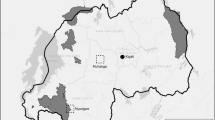Abstract
Environmental issues such as global change, acidic deposition, and toxic wastes will continue to be of great economic, political, and social concern during the coming decades. Ecological pressures on the earth’s limited natural resources will increase as human activities continue to alter the earth’s ecosystems. Part of the problem in the past has been the tradition of dealing independently with environmental issues related to land, air, and water resources. Because these components of the environment are intricately linked and often codependent, dealing with them independently has often led to the environmental degradation of both natural and developed areas (Viessman, 1990). The challenge of develo** an effective monitoring program and selecting key ecological indicators is to integrate all resources in order to provide quantitative assessments of the effects of pollutants and environmental change on all ecosystem components.
Access this chapter
Tax calculation will be finalised at checkout
Purchases are for personal use only
Preview
Unable to display preview. Download preview PDF.
Similar content being viewed by others
References
Applications Working Group. (1987). Linking remote sensing technology and global needs: A strategic vision. Report to National Aeronautic and Space Administration (NASA).
Bonham, C. D. (1989). Measurements for terrestrial vegetation. New York, John Wiley and Sons.
Crumpacker, D. W. (1984). Regional riparian research and a multi-university approach to the special problem of livestock grazing in the Rocky Mountains and Great Plains. In California riparian systems, ed. R. E. Warner and K. M. Hendrix. 413–423. Berkeley, CA, University of California Press.
Dickinson, R. E., B. Pinty and M. M. Verstraete. (1990). Relating surface albedos in GCM to remotely sensed data. Agricultural and Forest Meteorology, 52, 109–131.
Dregne, H. (1977). Desertification of arid lands. Econ. Geog., 53(4), 325.
Green, R. H. (1979). Sampling design and Statistical methods for environmental biologists. New York, John Wiley and Sons.
Harding, A. F. (1982). Climate change in later prehistory. Edinburgh, Edinburgh University Press.
Hunsaker, C. T. and D. E. Carpenter (ed.), (1990). Ecological indicators for the Environmental Monitoring and Assessment Program. EPA 600/3-90/060. U.S. EPA, Office of Research and Development, Research Triangle Park, NC.
Justice, C. O., J. R. G. Townshend, B. N. Holben and C. J. Tucker. (1985). Analysis of the phenology of global vegetation using meteorological satellite data. Int. Journal of Remote Sensing, 6(8) 1271–1318.
Maggs, W. W. (1989). Warming will alter water resources. EOS, 70, 67, 74.
Mooney, H. A. (1988). Lessons from Mediterranean-climate regions. In Biodiversity, ed. E. O. Wilson. Washington, DC, National Academy Press.
Noss, R. F. (1990). Indicators for monitoring biodiversity: A hierarchical approach, 355–364. USEPA.
Rapport, D. J. (1989). What constitutes ecosystem health. Perspectives in Biology and Medicine, 33(1), 120–132.
Schlesinger, W. H., J. F. Reynolds, G. L. Cunningham, L. F. Huenneke, W. M. Jarrell, R. A. Virginia and W. G. Whitford. (1990). Biological feedbacks in global desertification. Science, 247, 1043–1048.
Viessman, W. (1990). A framework for resha** water management. Environment 32(4), 10–15, 33–35.
Wharton, R. A., Jr., P. E. Wigand, M. R. Rose, R. L. Reinhardt, D. A. Mouat, H. E. Kleiforth, N. L. Ingraham, J. O. Davis, C. A. Fox and J. T. Ball. (1990). The North American Great Basin: A sensitive indicator of climatic change. In Plant biology of the basin and range, ed. C. B. Osmond, 323–359. Ecol. Studies Series, vol. 79, Springer-Verlag.
Author information
Authors and Affiliations
Editor information
Editors and Affiliations
Rights and permissions
Copyright information
© 1992 Springer Science+Business Media Dordrecht
About this chapter
Cite this chapter
Mouat, D.A., Fox, C.A., Rose, M.R. (1992). Ecological Indicator Strategy for Monitoring Arid Ecosystems. In: McKenzie, D.H., Hyatt, D.E., McDonald, V.J. (eds) Ecological Indicators. Springer, Boston, MA. https://doi.org/10.1007/978-1-4615-4659-7_41
Download citation
DOI: https://doi.org/10.1007/978-1-4615-4659-7_41
Publisher Name: Springer, Boston, MA
Print ISBN: 978-1-4613-7108-3
Online ISBN: 978-1-4615-4659-7
eBook Packages: Springer Book Archive




